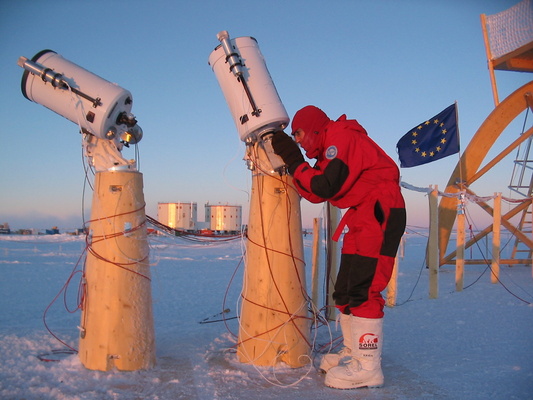4 min read
Some parts of the country feel as if the winter will never end. Massive snows, polar vortexes, artic winds...it’s almost enough to make you forget that a spring thaw will eventually arrive! One thing that is guaranteed to warm an astronomers' heart in these cold winter nights: the beautiful, sparking skies!
Orion, Taurus, the Pleiades, Sirius, the Andromeda Galaxy, the Double Custer in Perseus: these are just a few of the gorgeous sights that are at their peak in the winters of the Northern Hemisphere, not to mention the clockwork actions of the Moon and planets. But how can you observe and stay comfortable outside when the weather seems determined to turn you into a popsicle?
1. Layers are your friend!
You may already know this but remember to wear multiple layers of clothes! A super warm coat won't help that much if all you are wearing underneath is a t-shirt. At the same time, moving around during your setup and observing may heat you up to an uncomfortable degree, so being able to peel off a sweater or overcoat would be very welcome.
2. Warm, wool socks
Thick cozy socks are a must, especially as the night wears on. Your feet will thank you, especially if you are wearing good boots! Which brings us too...
3. Waterproof boots
You will want warm boots, and if there is snow, make sure your boots are also waterproof. Any water soaking through your shoes to your boots is a sure way to make your toes icy and prematurely end your observing.
4. Clear out your observing area
Is there snow on the ground where you usually set up? Bring a shovel and clear it out, even if there is just an inch or two of the white stuff. Your equipment and toes will thank you.
5. Ground padding
Kitchen floor mats and yoga mats are great to stand on during winter months. They act as a great, inexpensive buffer between your feet and the cold ground. Why not add one to your winter set up?
6. Blankets
Did you bring a blanket? Good. Even if you think you won't need one...you very well may want one after the first hour or so, especially if you are seated very still.
7. Gloves
Pack your gloves! Some astronomers prefer fingerless gloves that allow them to work on their instruments while outside, while others prefer combo mitten-gloves that allow you to flip the ends of the mittens off for fingerless glove access. Remember, you will be handling lots of cold metal as you set up your equipment in the cold so if you don't want your fingers going numb within minutes, gloves are a must!
8. Heat pads
Chemical or battery operated heating pads are your friend. Stick these little beauties into your gloves and boots to stay warm. If you use rechargeable heating pads, just make sure they are charged before you leave the house!
9. A big goofy hat and earmuffs
A hat with ear flaps? Big fuzzy earmuffs? You will definitely want these! While they may look a bit silly, you will be toasty inside, with nice warm ears rather than frigid lobes in danger of frostbite. Besides, you will be in the dark: who cares what you look like?
10. A warm thermos
A thermos full of your favorites warm liquid-hot chocolate, soup, coffee, tea- is your best friend during these long winter nights.
One final thing to remember: however cold you think you are, there is probably someone somewhere else who is in an even colder location...like, say, an amateur astronomer in Antarctica:

With these tips you are sure to have a much warmer and cozier time checking out the beautiful jewels of the winter night. Stay warm, and don't let the frost bite!
Originally posted by Dave Prosper: December 2016
Last Updated by Kat Troche: November 2023
